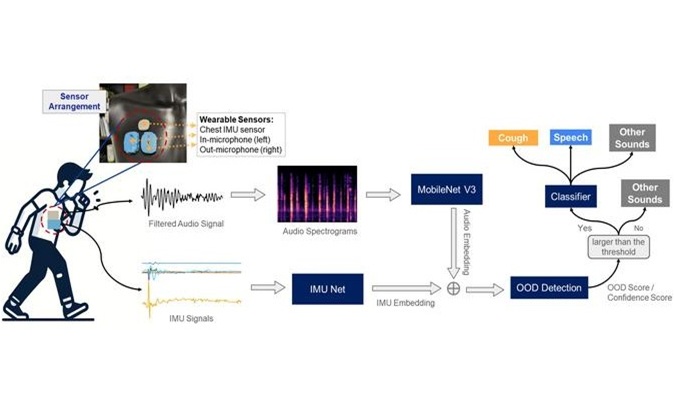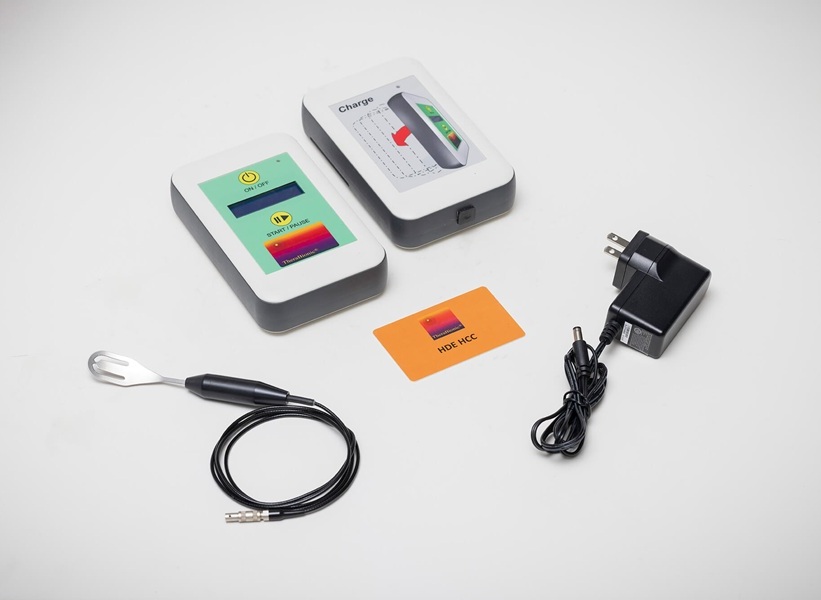COVID-19 Patients Face Higher Risk of Dangerous Blood Clots
|
By HospiMedica International staff writers Posted on 18 May 2020 |

Illustration
Researchers using a combination of two specific blood-clotting tests have found that critically ill COVID-19 patients were at a high risk of developing renal failure, venous blood clots, and other complications associated with blood clots, such as stroke.
The study by researchers from the University of Colorado Anschutz Medical Campus (Aurura, CO, USA), which was one of the first to build on growing evidence that COVID-19-infected patients are highly predisposed to developing blood clots, linked blood clotting measurements with actual patient outcomes.
Patients who are critically ill regardless of cause can develop a condition known as disseminated intravascular coagulation (DIC). The blood of these patients initially forms many clots in small blood vessels. The body's natural clotting factors can form too much clot or eventually not be able to effectively form any clot leading to issues of both excessive clotting and excessive bleeding. However, in patients with COVID-19 the clotting appears to be particularly severe and clots in COVID-19 patients do not appear to dissipate, according to Franklin Wright, MD, FACS, lead author of the research article and an assistant professor of surgery at the University of Colorado School of Medicine.
Trauma acute care surgeons and intensive care physicians who treat trauma, transplant, and cardiothoracic surgery patients at UCHealth University of Colorado Hospital used a specialized coagulation test to examine clotting issues in COVID-19 patients. Thromboelastography (TEG) is a whole blood assay that provides a broad picture of how an individual patient's blood forms clots, including how long clotting takes, how strong clots are, and how soon clots break down. TEG is highly specialized and used primarily by surgeons and anesthesiologists to evaluate the efficiency of blood clotting; it is not widely used in other clinical settings.
The researchers evaluated outcomes for all patients who had a TEG assay as part of their treatment for COVID-19 infection as well as other conventional coagulation assays, including ones that measure D-dimer levels. D-dimer is a protein fragment that is produced when a blood clot dissolves. D-dimer levels are elevated when large numbers of clots are breaking down. A total of 44 patients treated for COVID-19 infection between March 22 and April 20 were included in the analysis. Those whose bodies were not breaking down clots most often required hemodialysis and had a higher rate of clots in the veins. These patients were identified by TEG assays showing no clot breakdown after 30 minutes and a D-dimer level greater than 2600 ng/mL. 80% of patients with both affirmative test findings were placed on dialysis compared with 14% who tested for neither finding. Patients with affirmative test findings also had a 50% rate of venous blood clots compared with 0% for those patients with neither finding. The research team is now participating in a randomized clinical trial of a drug that breaks down blood clots in COVID-19-infected patients.
"This is an early step on the road to discovering treatments to prevent some of the complications that come with this disease," Dr. Wright said. "These study results suggest there may be a benefit to early TEG testing in institutions that have the technology to identify COVID-19 patients who may need more aggressive anticoagulation therapy to prevent complications from clot formation."
Related Links:
University of Colorado Anschutz Medical Campus
The study by researchers from the University of Colorado Anschutz Medical Campus (Aurura, CO, USA), which was one of the first to build on growing evidence that COVID-19-infected patients are highly predisposed to developing blood clots, linked blood clotting measurements with actual patient outcomes.
Patients who are critically ill regardless of cause can develop a condition known as disseminated intravascular coagulation (DIC). The blood of these patients initially forms many clots in small blood vessels. The body's natural clotting factors can form too much clot or eventually not be able to effectively form any clot leading to issues of both excessive clotting and excessive bleeding. However, in patients with COVID-19 the clotting appears to be particularly severe and clots in COVID-19 patients do not appear to dissipate, according to Franklin Wright, MD, FACS, lead author of the research article and an assistant professor of surgery at the University of Colorado School of Medicine.
Trauma acute care surgeons and intensive care physicians who treat trauma, transplant, and cardiothoracic surgery patients at UCHealth University of Colorado Hospital used a specialized coagulation test to examine clotting issues in COVID-19 patients. Thromboelastography (TEG) is a whole blood assay that provides a broad picture of how an individual patient's blood forms clots, including how long clotting takes, how strong clots are, and how soon clots break down. TEG is highly specialized and used primarily by surgeons and anesthesiologists to evaluate the efficiency of blood clotting; it is not widely used in other clinical settings.
The researchers evaluated outcomes for all patients who had a TEG assay as part of their treatment for COVID-19 infection as well as other conventional coagulation assays, including ones that measure D-dimer levels. D-dimer is a protein fragment that is produced when a blood clot dissolves. D-dimer levels are elevated when large numbers of clots are breaking down. A total of 44 patients treated for COVID-19 infection between March 22 and April 20 were included in the analysis. Those whose bodies were not breaking down clots most often required hemodialysis and had a higher rate of clots in the veins. These patients were identified by TEG assays showing no clot breakdown after 30 minutes and a D-dimer level greater than 2600 ng/mL. 80% of patients with both affirmative test findings were placed on dialysis compared with 14% who tested for neither finding. Patients with affirmative test findings also had a 50% rate of venous blood clots compared with 0% for those patients with neither finding. The research team is now participating in a randomized clinical trial of a drug that breaks down blood clots in COVID-19-infected patients.
"This is an early step on the road to discovering treatments to prevent some of the complications that come with this disease," Dr. Wright said. "These study results suggest there may be a benefit to early TEG testing in institutions that have the technology to identify COVID-19 patients who may need more aggressive anticoagulation therapy to prevent complications from clot formation."
Related Links:
University of Colorado Anschutz Medical Campus
Latest COVID-19 News
- Low-Cost System Detects SARS-CoV-2 Virus in Hospital Air Using High-Tech Bubbles
- World's First Inhalable COVID-19 Vaccine Approved in China
- COVID-19 Vaccine Patch Fights SARS-CoV-2 Variants Better than Needles
- Blood Viscosity Testing Can Predict Risk of Death in Hospitalized COVID-19 Patients
- ‘Covid Computer’ Uses AI to Detect COVID-19 from Chest CT Scans
- MRI Lung-Imaging Technique Shows Cause of Long-COVID Symptoms
- Chest CT Scans of COVID-19 Patients Could Help Distinguish Between SARS-CoV-2 Variants
- Specialized MRI Detects Lung Abnormalities in Non-Hospitalized Long COVID Patients
- AI Algorithm Identifies Hospitalized Patients at Highest Risk of Dying From COVID-19
- Sweat Sensor Detects Key Biomarkers That Provide Early Warning of COVID-19 and Flu
- Study Assesses Impact of COVID-19 on Ventilation/Perfusion Scintigraphy
- CT Imaging Study Finds Vaccination Reduces Risk of COVID-19 Associated Pulmonary Embolism
- Third Day in Hospital a ‘Tipping Point’ in Severity of COVID-19 Pneumonia
- Longer Interval Between COVID-19 Vaccines Generates Up to Nine Times as Many Antibodies
- AI Model for Monitoring COVID-19 Predicts Mortality Within First 30 Days of Admission
- AI Predicts COVID Prognosis at Near-Expert Level Based Off CT Scans
Channels
Critical Care
view channel
Origami Robots to Deliver Medicine Less Invasively and More Effectively
Delivering medicine to ulcers or other internal sites often requires invasive procedures that can disrupt surrounding tissues and lengthen recovery times. Traditional magnetic actuators used in soft robotics... Read more
Improved Cough-Detection Technology Aids Health Monitoring
Coughing serves as an important biomarker for tracking a variety of conditions and can help monitor the progress of respiratory diseases or predict when someone’s asthma is being exacerbated.... Read moreSurgical Techniques
view channel
Novel Glue Prevents Complications After Breast Cancer Surgery
Seroma and prolonged lymphorrhea are among the most common complications following axillary lymphadenectomy in breast cancer patients. These postoperative issues can delay recovery and postpone the start... Read more
Breakthrough Brain Implant Enables Safer and More Precise Drug Delivery
Delivering medication directly to specific regions of the brain has long been a major challenge in treating neurological disorders. Current implants and infusion systems typically reach only one or two... Read morePatient Care
view channel
Revolutionary Automatic IV-Line Flushing Device to Enhance Infusion Care
More than 80% of in-hospital patients receive intravenous (IV) therapy. Every dose of IV medicine delivered in a small volume (<250 mL) infusion bag should be followed by subsequent flushing to ensure... Read more
VR Training Tool Combats Contamination of Portable Medical Equipment
Healthcare-associated infections (HAIs) impact one in every 31 patients, cause nearly 100,000 deaths each year, and cost USD 28.4 billion in direct medical expenses. Notably, up to 75% of these infections... Read more
Portable Biosensor Platform to Reduce Hospital-Acquired Infections
Approximately 4 million patients in the European Union acquire healthcare-associated infections (HAIs) or nosocomial infections each year, with around 37,000 deaths directly resulting from these infections,... Read moreFirst-Of-Its-Kind Portable Germicidal Light Technology Disinfects High-Touch Clinical Surfaces in Seconds
Reducing healthcare-acquired infections (HAIs) remains a pressing issue within global healthcare systems. In the United States alone, 1.7 million patients contract HAIs annually, leading to approximately... Read moreHealth IT
view channel
Printable Molecule-Selective Nanoparticles Enable Mass Production of Wearable Biosensors
The future of medicine is likely to focus on the personalization of healthcare—understanding exactly what an individual requires and delivering the appropriate combination of nutrients, metabolites, and... Read moreBusiness
view channel
Philips and Masimo Partner to Advance Patient Monitoring Measurement Technologies
Royal Philips (Amsterdam, Netherlands) and Masimo (Irvine, California, USA) have renewed their multi-year strategic collaboration, combining Philips’ expertise in patient monitoring with Masimo’s noninvasive... Read more
B. Braun Acquires Digital Microsurgery Company True Digital Surgery
The high-end microsurgery market in neurosurgery, spine, and ENT is undergoing a significant transformation. Traditional analog microscopes are giving way to digital exoscopes, which provide improved visualization,... Read more
CMEF 2025 to Promote Holistic and High-Quality Development of Medical and Health Industry
The 92nd China International Medical Equipment Fair (CMEF 2025) Autumn Exhibition is scheduled to be held from September 26 to 29 at the China Import and Export Fair Complex (Canton Fair Complex) in Guangzhou.... Read more
















